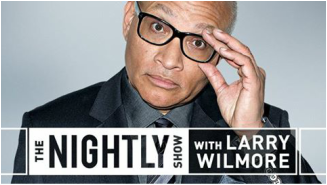 Wilmore and guests discuss Black fatherhood on The Nightly Show Wilmore and guests discuss Black fatherhood on The Nightly Show Tags: community, demography/population, marriage/family, media, methodology/statistics, prejudice/discrimination, race/ethnicity, fatherhood, larry wilmore, parenting, racism, stereotypes, subtitles/CC, 21 to 60 mins Year: 2014 Length: 21:29 Access: The Nightly Show Summary: When people hear the majority of Black babies are born “out-of-wedlock,” most either feel dismay or distrust at the statistic. However, Larry Wilmore and his panel of artists, authors, and activists confront the accuracy of this statistic and Black fatherhood more generally in a roundtable discussion. In Part 1, New York Times columnist Charles M. Blow explains how context matters, and the rate of births to unmarried Black women reflects the decline in fertility for married Black women, the mass incarceration of Black men, the diminishing importance placed on the traditional nuclear family, and the embracement of more flexible parental roles in our cultural more generally. Part 2 begins with a discussion about how media figures and politicians utilize deeply embedded racial (or racist) stereotypes to explain this statistic (and many others) in prejudicial ways. Part 2 then closes with the panelists offering their own experiences with their fathers and being dads themselves, thus revealing how in the interpreting of statistics many people (perhaps sociologists even more so than others) reify and over-generalize numbers, forgetting every “case” in a sample is actually a unique person, with their own unique experiences that is not readily apparent in macro data. Submitted By: Jason T. Eastman
4 Comments
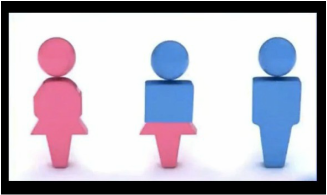 ISU adds gender-neutral labels to its restrooms ISU adds gender-neutral labels to its restrooms Tags: crime/law/deviance, gender, inequality, knowledge, lgbtq, media, prejudice/discrimination, sex/sexuality, social construction, agender, androgyne, bigender, gender fluid, genderqueer, neutrois, non-binary, trans*, transgender, 00 to 05 mins Year: 2014 Length: 0:50 Access: Mediaite Summary: In this clip from Fox & Friends Heather Nauert reports that Illinois State University recently relabeled its "family” restrooms as "gender-neutral." She kicks off the segment by saying,"Someone call the P.C. police!" and warns that viewers are "not going to believe this one.” The giddy laughter of her off-camera colleagues is audible while she delivers her exasperated explanation of the new restroom symbols. The video is useful in any class wrestling with the social construction of gender, the gender binary, and consequences of rigidly enforced gender categories. People who identify as transgender, two spirit, demiguy, demigirl, bigender, non-binary, trigender, third gender, genderqueer, gender fluid, androgyne, neutrois, and agender (and others) have often reported instances of ridicule and danger faced when using public restrooms. For this group, the labeling change means the difference between being able to safely use public restrooms at their university. What is interesting is not the change toward more inclusive signage at Illinois State University, but how Fox & Friends uses their platform as a major news network to actively police the gender binary. Nauert begins by framing the change as an instance of political correctness, a term that suggests the new signs are of trivial importance. The demeanor of both newscaster and her off-camera colleagues is another cue that viewers should not regard the change as an important or positive development at Illinois State University. Although times are changing, news programs still give lip service to the idea that their job is simply to give the public impartial (i.e., fair and balanced) information about important events. What is discussed less is the role the media plays in shaping the public's understanding of those events and reconstituting the state of affairs where excluding people who do not conform to the gender binary is acceptable. For more information about bathrooms as a site of gender politics, check out our Pinterest board on the topic. Submitted By: Lester Andrist 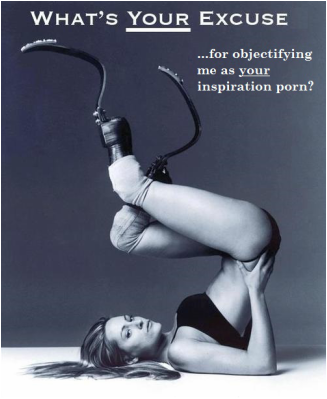 "What's your excuse...for objectifying me as your inspiration porn?" Amy Purdy poses while wearing her running blades "What's your excuse...for objectifying me as your inspiration porn?" Amy Purdy poses while wearing her running blades Tags: bodies, culture, disability, emotion/desire, inequality, knowledge, marketing/brands, media, sports, inspiration porn, super bowl, 00 to 05 mins Year: 2015 Length: 1:15 Access: YouTube Summary: Every year the Super Bowl proves to be a rich site for sociological investigation, and we have analyzed many different aspects of this American spectacle, including the commercials. All media, but the commercials of the Super Bowl in particular, can be seen as cultural artifacts. Ads are saturated with resonant images and meanings, and with a little work, one can deduce information about the society that created the ads, how they see themselves and what they believe about the world. The commercials of Super Bowl XLIX featured a surprising number of people with disabilities. Among them, Reebok and Toyota showcased athletes with prosthetic legs engaged in rather punishing exercise regiments. Our video of the week is the Toyota ad, which tracks world-class snowboarder and double amputee, Amy Purdy, on the slopes, in a dance hall, and as the subject of a photo shoot. Microsoft's ad, by contrast, centered on Braylon O'Neil, a toddler learning how to walk and play T-Ball with his prosthetic legs. All of the ads were accompanied by narration that attempted to inspire and somehow leave audiences with the impression that Microsoft, Toyota, or Reebok are central players in helping humanity realize its full potential. • The problem is that the ads reek of what is sometimes referred to as inspiration porn. That is, to the extent that people with disabilities feature in media at all, they are typically portrayed in a very one-dimensional way; as a narrative device that has been fashioned with the sole intent of inspiring the able-bodied majority. For those who think inspiration porn isn't a big deal, consider the awkward similarities it shares with the old practice of featuring people with disabilities as freaks in circus sideshows. Toyota is using Amy Purdy to inspire the able-bodied majority, whereas P. T. Barnum used double amputees to amuse. In both cases, people with disabilities are being objectified to give the majority a big emotional experience. Find more information and resources about disability and media representation on our Pinterest board. Submitted By: Lester Andrist  Power and money can shape what gets disseminated as "news". Power and money can shape what gets disseminated as "news". Tags: art/music, media, politics/election/voting, big business, censorship, ideology, political inequality, power, 06 to 10 mins Year: 2012 Length: 6:58 Access: YouTube Summary: This scene from the HBO series The Newsroom effectively captures how people in high-ranking institutional positions may exercise their incredibly great power. The clip illustrates how raw power serving vested interests can affect what is communicated to the masses as news. In this case, the owner of the media corporation (Leona played by Jane Fonda) is demanding that news division president, Charlie (Sam Waterston), straighten out the lead anchor, Will (played by Jeff Daniels), because of Will's efforts to report how big business has taken over the Tea Party. She specifically threatens to fire Will if he continues to follow the story. Art often imitates life, and notice that Leona references the Koch brothers in her tirade, and indeed they were targets of Will in this episode and another during 2012 (see this Wall Street Journal piece for criticism of the show's "Koch-kicking," and this AFL-CIO story for an opposite take). Also see how life imitates art as evident in this Salon.com article detailing the Koch brothers' efforts to censor public television programming. (Plans to produce a full-length documentary, Citizen Corp, which in part critically examined their political activities, were scrapped after the brothers threatened to withhold major funding from PBS. Nevertheless, the filmmakers were still able to raise enough money to complete the film, and then distribute it as Citizen Koch through theaters.) (Note: A version of this post originally appeared on SoUnequal.) Submitted By: Rene Gonzalez 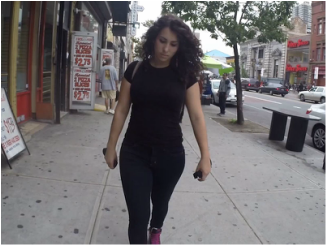 A scene from the Hollaback viral video of a woman walking in NYC A scene from the Hollaback viral video of a woman walking in NYC Tags: gender, inequality, intersectionality, media, prejudice/discrimination, race/ethnicity, violence, feminism, patriarchy, sexism, sexual harassment, street harassment, subtitles/CC, 00 to 05 mins Year: 2014 Access: YouTube (See also this supplemental video documenting the testimonies of women who have been street harassed) Summary: Street harassment has been a hot topic ever since the activist organization Hollaback! posted a slick new video, which records the catcalls aimed at a woman who walks for ten hours in New York City. While many men have described the video as opening their eyes to the harassment women face each day, many more men it seems have chided the video as little more than staged feminist wailing. They claim that in fact most women love compliments both on and off the street, and men have every right to simply say what's on their minds. For starters, the video can be used to recreate this core public debate in the classroom, thereby engaging students and communicating the relevancy of the material for their lives. Once the contours of this debate have been roughly defined, it is useful to bring both legal definitions and empirical evidence into the conversation with the aim of causing students to reevaluate their stance on street harassment and what they think they know about "most women" or "most men." In terms of legal definitions, it can be pointed out that street harassment falls under the CDC's definition of sexual violence, which it defines as any "sexual activity where consent is not obtained or freely given." Crucially, the CDC adds that not all forms of sexual violence "include physical contact between the victim and the perpetrator...for example, sexual harassment, threats, and peeping" (my emphasis; Stop Street Harassment offers a comparable definition). A second point to make is that whether women secretly love to be catcalled is an empirical question, and the evidence suggests they do not. In a recent nationally representative survey of 1,000 women and 1,000 men (age 18 and older), 65% of women reported experiencing at least one type of street harassment in their lifetimes. About 57% of all women had experienced verbal harassment, and 41% of all women had experienced physically aggressive forms, including sexual touching (23%), following (20%), flashing (14%), and being forced to do something sexual (9%). By comparison, only about 25% of men reported being street harassed. The majority of women who experienced harassment were at least somewhat concerned the incident might escalate. While the video is a vivid illustration of street harassment, it is not without fault. Writing for Colorlines, Akiba Solomon notes that although she likes the video as a teaching tool, one rather glaring problem with it is that the vast majority of men bothering the woman are black and Latino. The ad agency responsible for editing admitted that most white men who catcalled the twenty-something woman didn't make the final cut because the audio was less clear, Solomon rightly points out that by posting the video with the white perpetrators erased—whatever the justification—Hollaback! is engaging in "a dangerous lie of omission and implying that black and brown men are particularly predatory." In my view, Solomon's intersectional critique of the film needs to take centerstage in any discussion involving this video, for if we're not careful, the fight to end sexist harassment will come at the expense of establishing new justifications for racist harassment (Check out other posts on street harassment from The Sociological Cinema here, here, and here, and explore the topic on our Pinterest board here). Submitted By: Lester Andrist 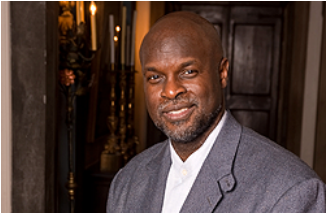 Dr. Tukufu Zuberi explains his concept of "film sociology." Dr. Tukufu Zuberi explains his concept of "film sociology." Tags: media, documentary, film, film sociology, public sociology, 21 to 60 mins Year: 2013 Length: 46:06 Access: YouTube Summary: This video lecture is from Dr. Tukufu Zuberi, an acclaimed sociologist, host of PBS' History Detectives, award winning documentary filmmaker, and museum curator. In the video, he defines and gives examples of a concept he calls "film sociology." He describes this as using film "as a space for a kind of critical sociology, a way to engage people to understand their world in a way that allows them to critique it and make it better." His commentary discusses the importance of using individual biographies in film to teach the sociological imagination, the role of visual narratives in scholarship, the choices of visual and audio in communicating empirical research, the importance of using film to tell a narrative that helps us to understand our social context, and his experiences in making film for documentaries and television. This video is the 2013 Fritz Nova Lecture at Villanova University. Submitted By: Tukufu Zuberi  The Healing Blues Project communicates the struggles of homelessness. The Healing Blues Project communicates the struggles of homelessness. Tags: art/music, community, economic sociology, inequality, media, affordable housing, empowerment, homelessness, 00 to 05 mins Year: 2014 Length: 5:05 Access: YouTube Summary: This music video, "I Die a Little," offers a first person narrative written and created by a sociology professor, media theorist, journalist, and a woman experiencing homelessness. Amidst the lyrics describing the struggles of homelessness, facts and statistics about homelessness appear throughout the video. It notes, for example, that "teens age 12 to 17 are more likely to become homeless than adults" and that "1 in 6 Americans live on incomes that put them at risk for hunger." Accordingly, it conveys both the structural causes of homelessness (e.g. lack of affordable housing and low-wage jobs) and its human face. The video is part of The Healing Blues Project, a community based project spearheaded by Greensboro College that partners local musicians, artists, and philanthropists with individuals from the homeless community in order to share their experience, strength, and hope. The larger collection (Healing Blues Vol 1) tells the stories of 13 individuals, all different yet somehow the same; they are joined together through the messages of humanity, hope, and love expressed in their songs. Proceeds from the Healing Blues Project go to the Interactive Resource Center, a community based outreach and resource provider, in Greensboro, North Carolina. The musicians from Haymarket Riot donated their performances to the project, and the homeless storytellers, as co-authors of the songs, receive a share of the royalties. It is also an example of the authors' use of cybertheory, which they describe as using the current technologies of postmodernity "to produce a multimedia theoretical 'text.'” Submitted By: HayMarket Riot 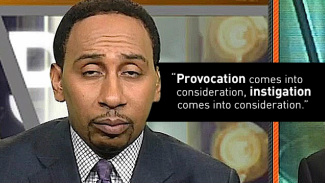 Stephen A. Smith blames the victim in an ESPN broadcast Stephen A. Smith blames the victim in an ESPN broadcast
Tags: crime/law/deviance, discourse/language, gender, inequality, media, sports, violence, assault, blaming the victim, domestic abuse, intimate partner violence, nfl, 00 to 05 mins
Year: 2014 Length: 2:15 Access: YouTube Summary: [Trigger warning for a discussion of domestic abuse and intimate partner violence] An important news story has once again put the spotlight on America's problem with domestic abuse and gender-based violence, and it involves (former) Baltimore Ravens running back Ray Rice assaulting then fiancée, Janay Palmer, in an elevator of an Atlantic City casino. Video footage of the incident confirms the couple got into a heated argument, and then somewhere during the course of the elevator's descent toward the lobby, Rice delivered a blow with enough force to seemingly render Palmer unconscious. A security camera from the lobby captures Rice dragging his fiancée's limp body out of the elevator and onto the lobby floor. Isn't this just an isolated incident of a man losing his temper? Since most men and women agree that physically assaulting another person is wrong, what is left to discuss? Here's something to consider: women are victims of rape and assault at the hands of men far more than the reverse. According to the Department of Justice, about 1 in 4 women have been victimized by an intimate partner, and this asymmetry suggests Americans still have much to discuss in terms of gendered patterns of violence. The same is true for only about 7% of all men. To be sure, there are certainly interpersonal details that led Rice and Palmer to quarrel that day, but it is no less true that Ray Rice assaulted Janay Palmer because Ray Rice lives in a society where it is sometimes permissible, and even expected, for men to enact physical violence against women. Sure, in the abstract, people agree it's wrong, but if one listens to how people actually make sense of instances of assault, it becomes clear that assault against women is only wrong with qualifications. For instance, the above video features commentator Stephen A. Smith on ESPN's "First Take" imploring viewers to "make sure we [sic] don’t do anything to provoke wrong actions.” As a sociologist, I can appreciate the importance of contextualizing social phenomena, but understanding the causal chain of events that lead to a given conflict is something different than excusing violence or saying the violence is understandable (i.e., morally acceptable). Rather than using his media platform to simply denounce Rice's behavior as wrong, Smith appears to ask his audience to consider the ways in which Janay Palmer was asking to be hit. In the spirit of truly contextualizing the abuse, Smith would do well to ask viewers to consider how a discourse of blaming the victim (also discussed here) perpetuates a state of affairs where women are the overwhelming victims of physical abuse (Note that Smith later offered an apology for his comments). Submitted by: Lester Andrist  Race and gender shaped the media's "thug" portrayal of Sherman. Race and gender shaped the media's "thug" portrayal of Sherman. Tags: discourse/language, emotion/desire, gender, intersectionality, media, prejudice/discrimination, race/ethnicity, sports, American football, racialized masculinity, racism, 06 to 10 mins Year: 2014 Length: 6:39 Access: msnbc Summary: On January 19, 2014, the Seattle Seahawks defeated the San Francisco 49ers in a game thrilling victory that secured their spot in Super Bowl XLVIII (which they went on to win). Immediately following the Seahawks' defeat over the 49ers, Seattle cornerback Richard Sherman gave an emotional, on-field post-game interview with FOX Sports reporter Erin Andrews. In the interview, Sherman portrayed a loud and brash display of aggression, in which he “trash talked” San Francisco receiver Michael Crabtree. In this clip, political commentator and TV host Chris Hayes highlights how the media framed Sherman--a black football player--as a “thug” after the interview. Hayes discusses the framing of black men and athletes as violent and hypermasculine with Dr. Jelani Cobb from the University Connecticut. This clip would be useful to guide discussions on the intersections of race and gender, racialized masculinity, and perceptions of threat and violence. Submitted By: Denae Johnson 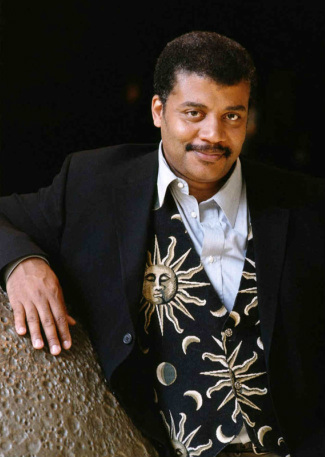 Neil deGrasse Tyson discusses the greatest obstacle he faced. Neil deGrasse Tyson discusses the greatest obstacle he faced. Tags: culture, discourse/language, knowledge, media, prejudice/discrimination, race/ethnicity, science/technology, politics of representation, symbolic representation, stereotypes, 11 to 20 mins Year: 2013 Length: 13:04 Access: YouTube Summary: In this insightful gem of a clip, Thomas Cech, president of the Howard Hughes Medical Institute, interviews world-renowned astrophysicist Neil deGrasse Tyson and asks him to recount the greatest obstacle he has faced while pursuing his career. Tyson begins by mentioning that while his parents were generally supportive of his ambitions, he couldn't necessarily count on the same enthusiasm and support from his peers, who were concerned that he apply his impressive intellect toward a profession that would allow him to advance the cause of the African American community. Specifically, Tyson recounts the story of a black Rhodes scholar in economics, who upon hearing that Tyson's chosen major was physics, replied, "The black community cannot afford the luxury of someone with your intellect to spend it on that subject." Tyson carried this nagging judgement around with him, and then while a graduate student at Columbia University, he was interviewed on air by the local news station regarding a recent explosion on the surface of the sun. Tyson explains in this clip that as he watched himself on television that evening, he realized it was the first time he had ever seen an interview with a black person that had nothing to do with being black. The clip works well as a foray into a broader discussion about what Stuart Hall calls the politics of representation, which draws attention to fact that how one imagines a people to exist in the world—how they are represented in discourse—holds consequences for the power and resources those people are able to control and wield. Neil deGrasse Tyson's story underscores Hall's thinking on the issue. Namely, "events, relations, structures do have conditions of existence and real effects, outside the sphere of the discursive; but that it is only within the discursive...[that] they can be constructed with meaning...how things are represented and the 'machineries' and regimes of representation in a culture do play a constitutive, and not merely a reflexive, after-the-event, role" (444). Thus, Tyson's answer to the Rhode's scholar is that his visible position as a black astrophysicist constitutes an important intervention in the discourse that attempts to construct black men as unqualified for the role of scientific expert. Submitted By: Lester Andrist |
Tags
All
.
Got any videos?
Are you finding useful videos for your classes? Do you have good videos you use in your own classes? Please consider submitting your videos here and helping us build our database!
|
 RSS Feed
RSS Feed
